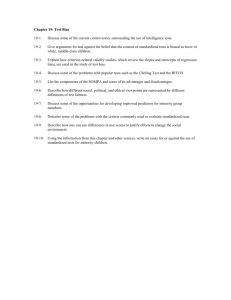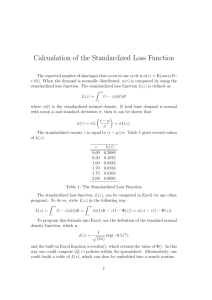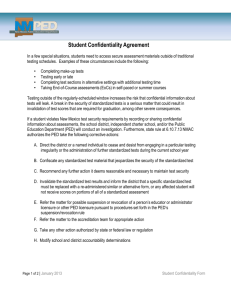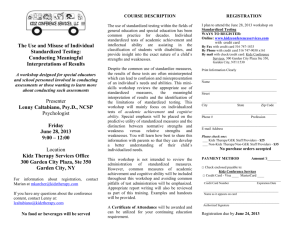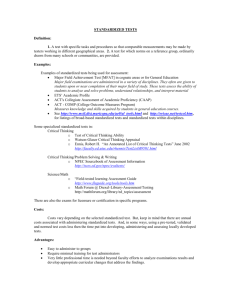Standards: How the West was Won
advertisement
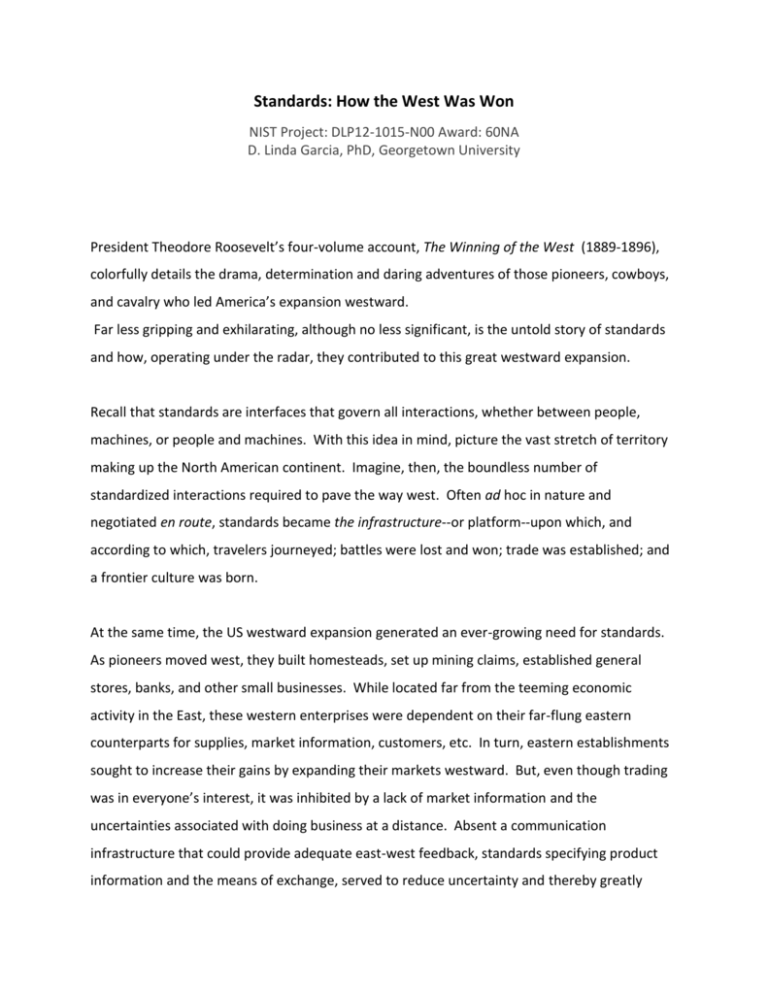
Standards: How the West Was Won NIST Project: DLP12-1015-N00 Award: 60NA D. Linda Garcia, PhD, Georgetown University President Theodore Roosevelt’s four-volume account, The Winning of the West (1889-1896), colorfully details the drama, determination and daring adventures of those pioneers, cowboys, and cavalry who led America’s expansion westward. Far less gripping and exhilarating, although no less significant, is the untold story of standards and how, operating under the radar, they contributed to this great westward expansion. Recall that standards are interfaces that govern all interactions, whether between people, machines, or people and machines. With this idea in mind, picture the vast stretch of territory making up the North American continent. Imagine, then, the boundless number of standardized interactions required to pave the way west. Often ad hoc in nature and negotiated en route, standards became the infrastructure--or platform--upon which, and according to which, travelers journeyed; battles were lost and won; trade was established; and a frontier culture was born. At the same time, the US westward expansion generated an ever-growing need for standards. As pioneers moved west, they built homesteads, set up mining claims, established general stores, banks, and other small businesses. While located far from the teeming economic activity in the East, these western enterprises were dependent on their far-flung eastern counterparts for supplies, market information, customers, etc. In turn, eastern establishments sought to increase their gains by expanding their markets westward. But, even though trading was in everyone’s interest, it was inhibited by a lack of market information and the uncertainties associated with doing business at a distance. Absent a communication infrastructure that could provide adequate east-west feedback, standards specifying product information and the means of exchange, served to reduce uncertainty and thereby greatly expand trade. As trade increased, so did the scope and intensity of interactions, and hence the need for additional standards. Not surprisingly, given this context, some of the most important standards developed during this period were those related to the communication of market information and the mechanisms of exchange. As the late James Beniger pointed out in his seminal work, The Control Revolution: Technologic and Economic Origins of the Information Society, market conditions and prices fluctuated widely from place to place. Lawlessness and opportunism were commonplace. To generate the stable conditions and levels of trust essential for trade to take place, standard economic processes and practices were required. Consider the standardized roles of the middlemen who managed the trading process. They were central in this regard. Included among these roles was that of the commission agent, or factor, who carried out business on behalf of a merchant in distant markets; the broker, who brought buyers and sellers together; the financiers who provided a credit network to cover the up-front costs of transporting, processing, and distributing goods, as well as retailers and other distributors, such as auctioneers and wholesale jobbers, the latter being of upmost importance in supplying western retailers. Equally important were the standardized trading forms and formats that helped to regularize trade by providing greater predictability. Standard invoices, for example, were used to document sales. The bill of lading was employed not only as a receipt, but also as proof of ownership, as well as a negotiable instrument that could be traded for goods or used as collateral to back a loan. Equally significant were catalogs that displayed standardized products, and listed their fixed prices. Formal institutions, which led to the standardization of business practices, emerged as well. Among these were common carriers--such as the postal service and the railroads, which-operating according to standardized procedures and a fixed schedule--allowed trade to take place on a consistent, periodic basis. Of equal consequence, according to Beniger, was the development of commercial law and legal precedents standardizing corporations; government prescriptions laying out a framework for interstate commerce; the chartering of insurance companies and commercial banks; businesses providing commercial credit ratings, and standardized ways to sort, grade, weigh, and inspect agricultural products, to name a few. Eighteenth century standards served not only to facilitate east-west trade; by conveying product information, they also provided greater quality control. One of the first product areas to benefit from standards was that of food. For example, responding to scandals in the meat packing industry, Congress passed the Pure Food and Drug Act of 1906. This legislation not only protected against misbranding and food adulteration; it also standardized containers for marketing fruits and vegetables, thereby eliminating false measurements and deceptive shapes. When employed as trademarks, such quality standards increased the value of goods; they allowed producers to differentiate their products from those of their competitors, and to price products to different markets. To this end, American farmers played a major role in setting agricultural standards. They realized that by grading and classifying their products, they could set up separate distribution channels and increase their profits. Thus, when moving west, farmers labeled their products by their region of origin, while wholesalers used these names -Goschen butter, Genessee flour, and Herkimer cheese -- as designations of grade. By the end of the century, these quality standards efforts took the form of branding. Notable in this regard was Henry P. Cromwell’s success in packaging and advertising oats, previously considered fodder for animals, as a healthy breakfast cereal using the brand name Quaker. With the deployment of the telegraph and the completion, between 1851 and 1854, of the four major trunk lines linking the East and West, one might say that the West was finally won. With the advent of steam powered railroads, activities and interactions that had once taken place at a snail’s pace were suddenly accelerated, greatly increasing the flow of people, goods, innovations and investments to the West. But, it is well worth noting that the railroads, operating on such a vast scale, could not have played this role without a rash of new standards to alleviate the system’s complexity. As described by Beniger, these included not only standardized role assignments and operating procedures, but also innovations such as through bills of lading, standardized cars, uniform standard time, standardized track gauges, as well as standardized automatic couplers and air breaks. We have seen how critical standards were to the US western expansion. In subsequent modules we will consider how lessons about standards from earlier periods can be applied to our understanding of their role in the expansion of the global economy.
